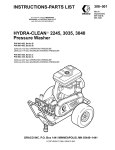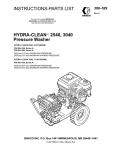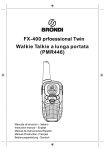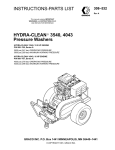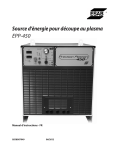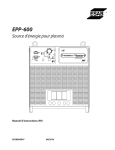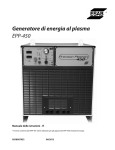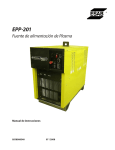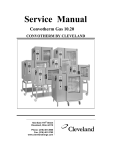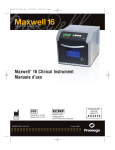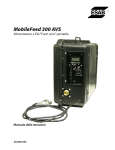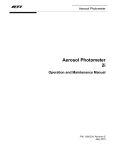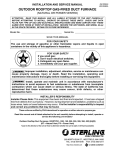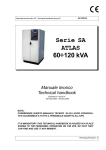Download EPP-600
Transcript
EPP-600 Generatore di corrente per arco al plasma Manuale di istruzioni (IT) 0558006950 08/2010 ACCERTARSI CHE L’OPERATORE RICEVA QUESTE INFORMAZIONI. È POSSIBILE RICHIEDERE ULTERIORI COPIE AL PROPRIO FORNITORE. ATTENZIONE Queste ISTRUZIONI sono indirizzate a operatori esperti. Se non si conoscono perfettamente i principi di funzionamento e le indicazioni per la sicurezza delle apparecchiature per la saldatura e il taglio ad arco, è necessario leggere l’opuscolo “Precauzioni e indicazioni per la sicurezza per la saldatura, il taglio e la scultura ad arco,” Modulo 52-529. L’installazione, l’uso e la manutenzione devono essere effettuati SOLO da persone adeguatamente addestrate. NON tentare di installare o utilizzare questa attrezzatura senza aver letto e compreso totalmente queste istruzioni. In caso di dubbi su queste istruzioni, contattare il proprio fornitore per ulteriori informazioni. Accertarsi di aver letto le Indicazioni per la sicurezza prima di installare o utilizzare questo dispositivo. RESPONSABILITÀ DELL’UTENTE Questo dispositivo funzionerà in maniera conforme alla descrizione contenuta in questo manuale e nelle etichette e/o gli allegati, se installato, utilizzato o sottoposto a manutenzione e riparazione sulla base delle istruzioni fornite. Questa attrezzatura deve essere controllata periodicamente. Non utilizzare attrezzatura che funzioni male o sottoposta a manutenzione insufficiente. Sostituire immediatamente i componenti rotti, mancanti, usurati, deformati o contaminati. Nel caso in cui tale riparazione o sostituzione diventi necessaria, il produttore raccomanda di richiedere telefonicamente o per iscritto assistenza al distributore autorizzato presso il quale è stata acquistata l’attrezzatura. Non modificare questo dispositivo né alcuno dei suoi componenti senza previo consenso scritto del produttore. L’utente di questo dispositivo sarà il solo responsabile per un eventuale funzionamento errato, derivante da uso non corretto, manutenzione erronea, danni, riparazione non corretta o modifica da parte di persona diversa dal produttore o dalla ditta di assistenza indicata dal produttore. NON INSTALLARE NÉ UTILIZZARE L’ATTREZZATURA PRIMA DI AVER LETTO E COMPRESO IL MANUALE DI ISTRUZIONI. PROTEGGERE SE STESSI E GLI ALTRI! indice Sezione / Titolo Pagina 1.0 Precauzioni per la sicurezza . . . . . . . . . . . . . . . . . . . . . . . . . . . . . . . . . . . . . . . . . . . . . . . . . . . . . . . . . . . . . . . . . . . . . . . . . . . . . . . . . . . 5 2.0 Descrizione . . . . . . . . . . . . . . . . . . . . . . . . . . . . . . . . . . . . . . . . . . . . . . . . . . . . . . . . . . . . . . . . . . . . . . . . . . . . . . . . . . . . . . . . . . . . . . . . . . 7 2.1 Introduzione . . . . . . . . . . . . . . . . . . . . . . . . . . . . . . . . . . . . . . . . . . . . . . . . . . . . . . . . . . . . . . . . . . . . . . . . . . . . . . . . . . . . . . . . . . . 7 2.2 Specifiche generali . . . . . . . . . . . . . . . . . . . . . . . . . . . . . . . . . . . . . . . . . . . . . . . . . . . . . . . . . . . . . . . . . . . . . . . . . . . . . . . . . . . . . 7 2.3 Dimensioni e peso . . . . . . . . . . . . . . . . . . . . . . . . . . . . . . . . . . . . . . . . . . . . . . . . . . . . . . . . . . . . . . . . . . . . . . . . . . . . . . . . . . . . . 8 3.0 Installazione . . . . . . . . . . . . . . . . . . . . . . . . . . . . . . . . . . . . . . . . . . . . . . . . . . . . . . . . . . . . . . . . . . . . . . . . . . . . . . . . . . . . . . . . . . . . . . . . . 9 3.1 Informazioni generali . . . . . . . . . . . . . . . . . . . . . . . . . . . . . . . . . . . . . . . . . . . . . . . . . . . . . . . . . . . . . . . . . . . . . . . . . . . . . . . . . . 9 3.2 Disimballo . . . . . . . . . . . . . . . . . . . . . . . . . . . . . . . . . . . . . . . . . . . . . . . . . . . . . . . . . . . . . . . . . . . . . . . . . . . . . . . . . . . . . . . . . . . . . 9 3.3 Collocazione . . . . . . . . . . . . . . . . . . . . . . . . . . . . . . . . . . . . . . . . . . . . . . . . . . . . . . . . . . . . . . . . . . . . . . . . . . . . . . . . . . . . . . . . . . . 9 3.4 Collegamenti corrente alternata in ingresso . . . . . . . . . . . . . . . . . . . . . . . . . . . . . . . . . . . . . . . . . . . . . . . . . . . . . . . . . . . . 10 3.5 Collegamento in uscita . . . . . . . . . . . . . . . . . . . . . . . . . . . . . . . . . . . . . . . . . . . . . . . . . . . . . . . . . . . . . . . . . . . . . . . . . . . . . . . . 12 3.6 Installazione parallela . . . . . . . . . . . . . . . . . . . . . . . . . . . . . . . . . . . . . . . . . . . . . . . . . . . . . . . . . . . . . . . . . . . . . . . . . . . . . . . . . 13 3.7 Cavi d’interfaccia . . . . . . . . . . . . . . . . . . . . . . . . . . . . . . . . . . . . . . . . . . . . . . . . . . . . . . . . . . . . . . . . . . . . . . . . . . . . . . . . . . . . . . 16 4.0 Funzionamento . . . . . . . . . . . . . . . . . . . . . . . . . . . . . . . . . . . . . . . . . . . . . . . . . . . . . . . . . . . . . . . . . . . . . . . . . . . . . . . . . . . . . . . . . . . . . 19 4.1 Descrizione del circuito con schema a blocchi . . . . . . . . . . . . . . . . . . . . . . . . . . . . . . . . . . . . . . . . . . . . . . . . . . . . . . . . . . 19 4.2 Pannello di controllo . . . . . . . . . . . . . . . . . . . . . . . . . . . . . . . . . . . . . . . . . . . . . . . . . . . . . . . . . . . . . . . . . . . . . . . . . . . . . . . . . . 22 4.3 Sequenza di funzionamento . . . . . . . . . . . . . . . . . . . . . . . . . . . . . . . . . . . . . . . . . . . . . . . . . . . . . . . . . . . . . . . . . . . . . . . . . . . 26 4.4 Impostazioni d’innesco dell’arco . . . . . . . . . . . . . . . . . . . . . . . . . . . . . . . . . . . . . . . . . . . . . . . . . . . . . . . . . . . . . . . . . . . . . . . 27 4.5 Curve v-I dell’EPP-600 . . . . . . . . . . . . . . . . . . . . . . . . . . . . . . . . . . . . . . . . . . . . . . . . . . . . . . . . . . . . . . . . . . . . . . . . . . . . . . . . . 30 5.0 Manutenzione . . . . . . . . . . . . . . . . . . . . . . . . . . . . . . . . . . . . . . . . . . . . . . . . . . . . . . . . . . . . . . . . . . . . . . . . . . . . . . . . . . . . . . . . . . . . . . 5,1 Informazioni generali . . . . . . . . . . . . . . . . . . . . . . . . . . . . . . . . . . . . . . . . . . . . . . . . . . . . . . . . . . . . . . . . . . . . . . . . . . . . . . . . . 5.2 Pulizia . . . . . . . . . . . . . . . . . . . . . . . . . . . . . . . . . . . . . . . . . . . . . . . . . . . . . . . . . . . . . . . . . . . . . . . . . . . . . . . . . . . . . . . . . . . . . . . . 5.3 Lubrificazione . . . . . . . . . . . . . . . . . . . . . . . . . . . . . . . . . . . . . . . . . . . . . . . . . . . . . . . . . . . . . . . . . . . . . . . . . . . . . . . . . . . . . . . . 6.0 Individuazione e risoluzione di problemi . . . . . . . . . . . . . . . . . . . . . . . . . . . . . . . . . . . . . . . . . . . . . . . . . . . . . . . . . . . 35 6.1 Informazioni generali . . . . . . . . . . . . . . . . . . . . . . . . . . . . . . . . . . . . . . . . . . . . . . . . . . . . . . . . . . . . . . . . . . . . . . . . 35 6.2 Indicatori di anomalia . . . . . . . . . . . . . . . . . . . . . . . . . . . . . . . . . . . . . . . . . . . . . . . . . . . . . . . . . . . . . . . . . . . . . . . . 35 6.3 Isolamento dell’anomalia . . . . . . . . . . . . . . . . . . . . . . . . . . . . . . . . . . . . . . . . . . . . . . . . . . . . . . . . . . . . . . . . . . . . 38 6.4 Verifica e sostituzione dei componenti . . . . . . . . . . . . . . . . . . . . . . . . . . . . . . . . . . . . . . . . . . . . . . . . . . . . . . . 46 6.5 Interfaccia del circuito di controllo che usa connettori J1 e J6 . . . . . . . . . . . . . . . . . . . . . . . . . . . . . . . . . . 52 6.6 Contattore principale ausiliario (K3) e circuiti del contattore a stato solido . . . . . . . . . . . . . . . . . . . . . . 54 6.7 Circuito di attivazione del contattore principale (K1A, K1B e K1C) . . . . . . . . . . . . . . . . . . . . . . . . . . . . . . . 55 6.8 Circuiti rilevatore corrente dell’arco . . . . . . . . . . . . . . . . . . . . . . . . . . . . . . . . . . . . . . . . . . . . . . . . . . . . . . . . . . . 56 6.9 Resistore di controllo corrente e Vref remoto . . . . . . . . . . . . . . . . . . . . . . . . . . . . . . . . . . . . . . . . . . . . . . . . . . 57 6.10 Arco pilota AL / BA e circuiti di taglio/marcatura . . . . . . . . . . . . . . . . . . . . . . . . . . . . . . . . . . . . . . . . . . . . . . . 58 7.0 Pezzi di ricambio . . . . . . . . . . . . . . . . . . . . . . . . . . . . . . . . . . . . . . . . . . . . . . . . . . . . . . . . . . . . . . . . . . . . . . . . . . . . . . . . . . 59 7.1 Informazioni generali . . . . . . . . . . . . . . . . . . . . . . . . . . . . . . . . . . . . . . . . . . . . . . . . . . . . . . . . . . . . . . . . . . . . . . . . 59 7.2 Inoltro degli ordini . . . . . . . . . . . . . . . . . . . . . . . . . . . . . . . . . . . . . . . . . . . . . . . . . . . . . . . . . . . . . . . . . . . . . . . . . . 59 33 33 33 34 4 seZionE 1 1.0 INDICAZIONI PER LA SICUREZZA Indicazioni per la sicurezza Gli utenti dell’attrezzatura per la saldatura e il taglio al plasma ESAB hanno la responsabilità di accertarsi che chiunque lavori al dispositivo o accanto ad esso adotti tutte le idonee misure di sicurezza. Le misure di sicurezza devono soddisfare i requisiti che si applicano a questo tipo di dispositivo per la saldatura o il taglio al plasma. Attenersi alle seguenti raccomandazioni, oltre che ai regolamenti standard che si applicano al luogo di lavoro. Tutto il lavoro deve essere eseguito da personale addestrato, perfettamente al corrente del funzionamento dell’attrezzatura per la saldatura o il taglio al plasma. Il funzionamento errato dell’attrezzatura può determinare situazioni pericolose con conseguenti lesioni all’operatore e danni al dispositivo stesso. 1. Chiunque utilizzi attrezzatura per la saldatura o il taglio al plasma deve conoscerne perfettamente: - il funzionamento - la posizione degli arresti di emergenza - la funzione - le idonee misure di sicurezza - la saldatura e/o il taglio al plasma 2. L’operatore deve accertarsi che: - nessuna persona non autorizzata si trovi nell’area operativa dell’attrezzatura quando questa viene messa in funzione. - tutti siano protetti quando si esegue l’arco. 3. Il luogo di lavoro deve essere: - idoneo allo scopo - privo di correnti d’aria 4. Attrezzature per la sicurezza personale: - indossare sempre l’attrezzatura di sicurezza personale raccomandata, come occhiali di sicurezza, abbigliamento ignifugo, guanti di sicurezza. - non indossare oggetti sporgenti, come sciarpe, braccialetti, anelli, ecc., che potrebbero rimanere intrappolati o causare ustioni. 5. Precauzioni generali: - accertarsi che il cavo di ritorno sia collegato saldamente; - il lavoro su apparecchiature ad alta tensione può essere effettuato sono da parte di tecnici qualificati; - i dispositivi antincendio idonei devono essere indicati chiaramente e a portata di mano; - durante il funzionamento non effettuare lavori di lubrificazione e manutenzione. Classe del contenitore Il codice IP indica la classe del contenitore, cioè il livello di protezione contro la penetrazione di oggetti solidi o acqua. La protezione viene fornita per evitare l’inserimento di dita, la penetrazione di oggetti solidi più grandi di 12 mm e gli spruzzi di acqua fino a 60 gradi di inclinazione rispetto alla verticale. Le attrezzature marcate IP23S possono essere immagazzinate, ma non devono essere usate all’aperto in presenza di precipitazione senza un adeguato riparo. ATTENZIONE Inclinazione massima consentita Se l’apparecchiatura è collocata su una superficie inclinata più di 15° si potrebbe verificare un ribaltamento, con conseguenti rischi di lesioni personali e/o danni rilevanti all’attrezzatura. 15° 5 seZionE 1 INDICAZIONI PER LA SICUREZZA AVVERTENZA LA SALDATURA E IL TAGLIO AL PLASMA POSSONO ESSERE PERICOLOSI PER L’OPERATORE E COLORO CHE GLI SI TROVANO ACCANTO. ADOTTARE LE OPPORTUNE PRECAUZIONI DURANTE LA SALDATURA O IL TAGLIO. INFORMARSI DELLE MISURE DI SICUREZZA ADOTTATE DAL PROPRIO DATORE DI LAVORO, CHE SI DEVONO BASARE SUI DATI RELATIVI AL PERICOLO INDICATI DAL PRODUTTORE. SCOSSA ELETTRICA - Può essere mortale - Installare e collegare a terra (massa) l’unità di saldatura o taglio al plasma sulla base degli standard applicabili. - Non toccare le parti elettriche o gli elettrodi sotto tensione con la pelle nuda e guanti o abbigliamento bagnato. - Isolarsi dalla terra e dal pezzo in lavorazione. - Accertasi che la propria posizione di lavoro sia sicura. FUMI E GAS - Possono essere pericolosi per la salute. - Tenere la testa lontano dai fumi. - Usare la ventilazione, l’estrazione fumi sull’arco o entrambe per mantenere lontani fumi e gas dalla propria zona di respirazione e dall’area in genere. I RAGGI DELL’ARCO - Possono causare lesioni agli occhi e ustionare la pelle. - Proteggere gli occhi e il corpo. Usare lo schermo di protezione per saldatura/taglio al plasma e lenti con filtro idonei e indossare abbigliamento di protezione. - Proteggere le persone circostanti con schermi o barriere di sicurezza idonee. PERICOLO DI INCENDIO - Scintille (spruzzi) possono causare incendi. Accertarsi quindi che nelle immediate vicinanze non siano pre senti materiali infiammabili. RUMORE - Il rumore in eccesso può danneggiare l’udito. - Proteggere le orecchie. Usare cuffie antirumore o altre protezioni per l’udito. - Informare le persone circostanti del rischio. GUASTI - In caso di guasti richiedere l’assistenza di un esperto. NON INSTALLARE NÉ UTILIZZARE L’ATTREZZATURA PRIMA DI AVER LETTO E COMPRESO IL MANUALE DI ISTRUZIONI. PROTEGGERE SE STESSI E GLI ALTRI! ATTENZIONE Questo prodotto è destinato esclusivamente al taglio del plasma. Qualsiasi altro utilizzo potrebbe provocare lesioni personali e/o danni alle apparecchiature. ATTENZIONE Per evitare lesioni personali e/o danni alle apparecchiature, sollevare utilizzando il metodo e i punti di aggancio indicati a fianco. 6 sezione 2descrizione 2.1 Introduzione Il generatore di corrente EPP è indicato per marcatura e applicazioni veloci di taglio meccanizzato al plasma. Lo si può usare con altri prodotti ESAB, quali le torce PT-15, Pt-19XLS, PT-600 e PT-36 insieme allo Smart Flow II, sistema computerizzato di accensione e regolazione gas. • • • • • • • • • Da 12 a 600 ampere per marcatura Intervallo corrente di taglio compreso tra 50 e 600 ampere Raffreddamento ad aria forzata Alimentazione CC a stato solido Protezione tensione in ingresso Comando pannello anteriore da locale o da remoto Termoprotezione per trasformatore principale e componenti semiconduttore di potenza Anelli di sollevamento superiori o spazio per forche di carrello elevatore alla base per il trasporto Capacità di generatore di corrente supplementare parallelo per aumentare il range della corrente in uscita. 2.2 Specifiche generali Numero di codice EPP-600 400V, 50 / 60Hz CE EPP-600 460V, 60Hz EPP-600 575V, 60Hz 0558006473 0558006474 0558006475 Tensione 200 VCC Intervallo di corrente CC (marcatura) da 12A a 600A Uscita Intervallo di corrente CC (ta(fattore di utilizzo glio) 100 %) Alimentazione da 50A a 600A 120 KW * Tensione circuito aperto (OCV) Ingresso 423 VCC 427 VCC 427 VCC Tensione (trifase) 400 V 460 V 575 V Corrente (trifase) 206A RMS 179A RMS 143A RMS Frequenza 50/60 HZ 60 Hz 60 Hz KVA 142.7 KVA 142,6 KVA 142,9 KVA Alimentazione 129,9 KW 129,8 KW 129,6 KW Fattore di potenza 91.0 % 91.0% 91.0% Fusibile in ingresso rac. 250A 250A 200A * La tensione del circuito aperto è ridotta a 290V nella modalità di marcatura per 460V e 575V, modelli da 60Hz, e per 310V per 400V, modelli da 50Hz. 7 sezione 2descrizione 2.3 Dimensioni e peso 114.3 cm 45.00” 94.6 cm 37.25” 102.2 cm 40.25” Peso = 825 kg (1814 libbre) 8 sezione 3installazione 3,1 Informazioni generali AVVERTENZA La mancata osservanza delle istruzioni può portare alla morte, a lesioni personali o a danni materiali. Per evitare qualsiasi lesione personale o danno materiale, seguire queste istruzioni. Attenersi a quanto indicato dalle norme elettriche e di sicurezza locali, statali e nazionali. 3.2 Disimballo cautela • • • L’uso di un solo golfare di sollevamento potrebbe danneggiare lamiera e telaio. Per il trasporto con sollevamento utilizzare gli appositi golfari. Al ricevimento, accertarsi immediatamente dell’assenza di eventuali danni causati dal trasporto. Estrarre tutti i componenti dal contenitore per la spedizione e accertarsi della presenza di tutti gli elementi sfusi. Accertarsi dell’assenza di ostacoli che possano impedire il flusso dell’aria attraverso le apposite feritoie. 3.3 Collocazione Nota: per il trasporto con sollevamento utilizzare gli appositi golfari. • • • • • Prevedere uno spazio minimo di 1 m (2 piedi) sulla parte anteriore e su quella posteriore, per consentire il flusso dell’aria di raffreddamento. Accertarsi che il pannello superiore e i pannelli laterali possano essere rimossi per consentire le operazioni di manutenzione, pulizia e ispezione. Collocare l’EPP-600 relativamente vicino a un alimentatore elettrico provvisto di fusibili adeguati. Mantenere libera la zona sottostante l’alimentatore per consentire il flusso dell’aria di raffreddamento. Accertarsi che l’ambiente sia relativamente privo di polvere, fumi o calore eccessivo. Questi fattori possono incidere sull’efficacia del raffreddamento. cautela La presenza di polvere conduttiva o sporco all’interno dell’alimentatore può causare una scarica esterna dell’arco (flashover). Si possono verificare danni all’attrezzatura. La formazione di polvere all’interno dell’alimentatore può provocare un cortocircuito. Consultare la sezione Manutenzione. 9 sezione 3installazione 3.4 Collegamenti corrente alternata in ingresso Le scosse elettriche possono essere mortali Fornire la massima protezione dalle scosse elettriche. Prima di eseguire i collegamenti all’interno della macchina, aprire il sezionatore di linea (a parete) per staccare l’alimentazione. AVVERTENZA 3.4.1 Alimentazione principale L’EPP-600 è un’unità trifase. La corrente in ingresso deve essere alimentata da un sezionatore di linea (a parete) contenente appositi fusibili o interruttori di circuito conformi alle normative locali o nazionali. Dimensioni consigliate per il conduttore di ingresso e i fusibili di linea: Ingresso a carico nominale Dimensioni fusibile ritardato (ampere) Volt Ampere Conduttore di ingresso e massa* CU/mm2 (AWG) 400 206 95 (4/0) 250 460 179 95 (3/0) 250** 575 143 50 (1/0) 200 In carico nominale è in uscita di 600A a 200V * Dimensioni come da disposizioni degli enti normativi NEC per conduttori in rame da 90° C (194˚ F) in un ambiente a 40° C (104˚ F). Non disporre più di tre conduttori in una stessa canalina o cavo. Attenersi alle normative locali qualora specifichino dimensioni diverse da quanto elencato di seguito. ** Durante applicazioni di taglio heavy duty a 600A, è possibile che a corrente di ingresso aumenti momentaneamente a 200A e causi la bruciatura dei fusibili da 200A. Quando le correnti di taglio sono inferiori ai 500A, i fusibili da 200A sono sufficienti. Per valutare la corrente di ingresso per una vasta gamma di condizioni di uscita, usare la formula seguente. Corrente di ingresso = NOTA (arco V) x (arco I) x 0,688 (linea V) Potrebbe essere necessaria una linea di alimentazione dedicata. L’EPP-600 prevede la compensazione della tensione di linea, tuttavia per evitare prestazioni inadeguate provocate da un sovraccarico del circuito, potrebbe essere necessaria una linea di alimentazione dedicata. 10 sezione 3installazione 3.4.2 Conduttori di ingresso • • • Non in dotazione Possono essere conduttori in rame ricoperti in gomma dura (tre di fase e uno di massa) o passare in un condotto solido o flessibile. Dimensionati secondo il grafico. I conduttori di ingresso devono terminare con O-ring. I conduttori di ingresso devono essere dotati di O-ring dimensionati per ferramenta da 12,7 mm (0,50”) prima di essere collegati all’EPP600. NOTA 3.4.3 Procedura di collegamento di ingresso 1 1. Rimuovere il pannello sinistro dell’EPP-600 2. Passare i cavi attraverso l’apertura di accesso del pannello posteriore. 3. Fissare i cavi con un pressacavo o un raccordo per tubo (non in dotazione) sull’apertura di accesso. 4. Collegare il cavo di massa con il perno sulla base del telaio. 5. Collegare gli O-ring dei cavi di alimentazione ai terminali principali con i bulloni, le rondelle e i dadi in dotazione. 6. Collegare i conduttori di ingresso al sezionatore di linea (a parete). 2 3 1 = Terminali principali 2 = Messa a terra del telaio 3 = Apertura di accesso del cavo di alimentazione di ingresso (pannello posteriore) 11 sezione 3installazione Le scosse elettriche possono essere mortali Deve essere presente uno spazio tra il pannello laterale e il trasformatore principale per gli o-ring. Tale spazio deve essere sufficiente a impedire la possibile creazione di arco. Accertarsi che i cavi non interferiscano con la rotazione della ventola di raffreddamento. AVVERTENZA AVVERTENZA Un collegamento a massa non corretto può causare morte o lesioni. Il telaio deve essere collegato a una messa a terra elettrica approvata. Accertarsi che il cavo di massa non sia collegato a un terminale primario. 3.5 Collegamenti in uscita AVVERTENZA Le scosse elettriche possono essere mortali! Tensione e corrente pericolose! Ogni volta che si lavora nei pressi di un generatore di tensione per plasma ad arco con i coperchi rimossi: • SCOLLEGARE IL GENERATORE DI TENSIONE DAL SEZIONATORE DI LINEA (A PARETE). • INCARICARE PERSONALE QUALIFICATO DEL CONTROLLO DEGLI ELETTRODI DI CONTATTO DI USCITA (POSITIVO E NEGATIVO) MEDIANTE VOLTMETRO. 3.5.1 Cavi di uscita (non in dotazione) Scegliere cavi di uscita per taglio al plasma (non in dotazione) sulla base di un cavo di rame isolato da 600 volt 4/0 AWG per ogni 400 amp di corrente di uscita. Nota: non usare un cavo di saldatura isolato da 100 volt. 12 sezione 3installazione 3.5.2 Procedura di collegamento di uscita 1. Rimuovere il pannello di accesso sulla parte anteriore inferiore del generatore di tensione. 2. Passare i cavi in uscita attraverso le aperture nella parte inferiore del pannello anteriore o in fondo al generatore di tensione immediatamente dietro il pannello anteriore. 3. Collegare i cavi ai relativi terminali montati nel generatore di tensione mediante connettori a pressione UL listed. 4. Riposizionare il pannello rimosso durante la prima fase. Pannello di accesso 3.6 Installazione parallela È possibile ampliare l'intervallo della corrente di uscita, collegando in parallelo due generatori di tensione EPP600. cautela La corrente in uscita minima del generatore di tensione parallelo supera i valori raccomandati durante operazioni di taglio inferiori a 100A. Usare sono generatori di tensione per taglio inferiori a 100A. Quando si passa a correnti inferiori a 100 A, raccomandiamo di scollegare la derivazione negativa dal generatore di tensione supplementare. Questa derivazione deve essere terminata in maniera sicura per proteggere da scosse elettriche. 13 sezione 3installazione 3.6.1 Collegamenti per due EPP-600 in parallelo Nota: il conduttore dell’elettrodo (-) del generatore di tensione principale è ponticellato. Il pezzo lavorato (+) del generatore di tensione supplementare è ponticellato. 1. 2. 3. 4. Collegare i cavi di uscita negativi (-) alla cassetta di avviamento dell’arco (generatore di alta frequenza). Collegare i cavi di uscita positivi (+) al pezzo lavorato. Collegare i conduttori positivo (+) e negativo (-) tra i generatori di tensione. Collegare il cavo dell’arco pilota al terminale dell’arco pilota nel generatore di tensione principale. Il collegamento dell’arco pilota al generatore di tensione supplementare non si usa. Il circuito dell’arco pilota non funziona in parallelo. 5. Impostare l’interruttore dell’arco pilota ALTO/BASSO al generatore di tensione supplementare su “BASSO”. 6. Impostare l’interruttore dell’arco pilota ALTO/BASSO sul generatore di tensione principale su “ALTO”. 7. Se si usa un segnale remoto di riferimento per la corrente da 0,00 a +10,00 VCC per impostare la corrente di uscita, alimentare lo stesso segnale in entrambi i generatori di tensione. Collegare rispettivamente i J1-G (positivi da 0,00 a 10,00 VCC) e i J1-P (negativi) di entrambi i generatori di tensione. Con entrambi i generatori di tensione operativi, la corrente di uscita si può predire mediante la seguente formula: [corrente di uscita (amp)] = [tensione di riferimento] x [160] Collegamenti per installazione parallela di due generatori di tensione EPP-600 con entrambi i generatori di tensione in funzione. EPP-600 EPP-600 Generatore di tensione supplementare elettrodo work (-) (+) 3 - 4/0 600V cavi positivi al pezzo lavorato work (+) 4/0 600V ponticelli dei cavi tra le unità Generatore di tensione principale arco pilota 1 - 14 AWG 600V connessione da cavo ad arco pilota nella cassetta di avviamento dell’arco (generatore di alta frequenza) 14 elettrodo (-) 3 - 4/0 600V cavi negativi nella cassetta di avviamento dell’arco (generatore di alta frequenza) sezione 3installazione L’EPP-600 non possiede un interruttore di accensione/spegnimento. L’alimentazione principale è controllata attraverso il sezionatore di linea (a parete). AVVERTENZA Non utilizzare l’EPP-600 con i coperchi rimossi. I componenti ad alta tensione sono esposti e di conseguenza il rischio di scossa elettrica è maggiore. Il componente interno può essere danneggiato poiché le ventole di raffreddamento perdono efficacia. Le scosse elettriche possono essere mortali I conduttori elettrici esposti possono essere pericolosi! AVVERTENZA Non lasciare esposti i conduttori sotto tensione. Quando si scollega il generatore supplementare da quello principale, verificare di scollegare i cavi corretti. Isolare le estremità scollegate. Quando si usa un solo generatore di tensione in una configurazione parallela, il conduttore dell’elettrodo negativo deve essere scollegato dal generatore supplementare e dalla cassetta. In caso contrario la fonte supplementare rimarrà sotto tensione. Collegamenti per installazione parallela di due generatori di tensione EPP-600 con un solo generatore di tensione in funzione. EPP-600 EPP-600 Generatore di tensione principale Generatore di tensione supplementare lavorazione 3 - 4/0 600V cavi positivi al pezzo lavorato elettrodo lavorazione Scollegare il collegamento negativo dal generatore supplementare e isolarlo per convertire da due a un generatore di tensione 15 elettrodo 3 - 4/0 600V cavi negativi nella cassetta di avviamento dell’arco (generatore di alta frequenza) sezione 3installazione 3.6.2 Marcatura con due EPP-600 paralleli Due EPP-600, collegati in parallelo e si possono utilizzare per marcatura fino a 24A e taglio da 100A a 1000A. Per consentire la marcatura fino a 12A si possono apportare due semplici modifiche al generatore di tensione supplementare. Le modifiche sono necessarie solo se è richiesta una marcatura fino a 12A. MODIFICHE DELL'UTENTE PER CONSENTIRE UNA MARCATURA FINO A 12A: 1. MODIFICHE AL GENERATORE DI TENSIONE PRIMARIO: Nessuna 2. MODIFICHE AL GENERATORE DI TENSIONE SUPPLEMENTARE: A. Scollegare il filo BIANCO dalla bobina del K12 B. Rimuovere il ponticello ORN dal TB7-11 e collegare entrambe le estremità del ponticello al TB7-12. FUNZIONAMENTO DI DUE EPP-600 PARALLELI: 1. Fornire i segnali Contattore On/Off, Taglio/Marcatura, e Arco pilota AL / BA alle unità Primaria e Supplementare per taglio e marcatura. Durante la marcatura, entrambi i generatori di tensione sono azionati, ma il segnale Marcatura disattiva l'uscita del generatore di tensione supplementare se è stato modificato per la marcatura fino a 12A. Se il generatore di tensione supplementare non è stato modificato, fornirà la stessa corrente in uscita di quello primario. 2. Alimentare lo stesso segnale VREF nelle unità Primaria e Supplementare per taglio e marcatura. Per installazioni con generatore di tensione secondario modificato, la funzione di trasferimento della corrente in uscita per la marcatura è quella del generatore di tensione primario: IOUT = 80 x VREF. Per il taglio, è la somma dei generatori di tensione primario e supplementare: IOUT = 160 x VREF. Per istallazioni con generatore di tensione secondario non modificato, la funzione di trasferimento della corrente in uscita per taglio e marcature è IOUT = 160 x VREF. 3.7 Cavi d'interfaccia Interfaccia CNC (24 Pin) Interfaccia raffreddamento ad acqua (8 Pin) 16 sezione 3installazione 3.7.1 Cavi d'interfaccia con connettore del generatore di tensione appaiato e interfaccia CNC non terminata MSS/GIA ROSSO n. 4 3.7.2 Cavi d'interfaccia CNC con connettori del generatore di tensione appaiato su entrambe le estremità MSS/GIA ROSSO n. 4 17 sezione 3installazione 3.7.3 Cavi d'interfaccia raffreddamento ad acqua con connettori del generatore di tensione appaiato su entrambe le estremità 18 (slave) PWM 19 CNC comune (mobile) S Circuito di controllo Rettificatore di bus 300U120 T Galvanico Isolatore Amplificatori di errore Vedere Nota Vedere nota T Moduli IGBT di destra Doppino Risposta per servocomando corrente costante Banco condensatore Moduli IGBT di destra Vedere nota L1 T T1 Picco 250V R (boost) Diodi di blocco Nota IGBT e diodi di libera circolazione sono contenuti nello stesso modulo. LAVORAZIONE UGELLO ELETTRODO Derivatore di precisione Circuito arco pilota R (circuito) Circuito Circuito di protezione polarizzato arco pilota Picco 425V T1 Contatto su pilota Contattore arco Sensore Hall destro Diodi di libera circolazione - Vedere nota Diodi di blocco L2 Sensore Hall destro EPP-600 SCHEMA A BLOCCHI “T” comune connesso con pezzo collegato a massa attraverso l’uscita “+” Risposta per servocomandi interni rapidi T1 Main Trasformatore -Bus CC 300V-375V Pilotaggio gate Segnale sinc. per commutazione alternata Pilotaggio gate 4.1 Descrizione del circuito con schema a blocchi Vref CC 0.0 – 10.0V Iout = (Vref) x (80) Trifase Ingresso H PWM Galvanico Isolatore Scheda di pilotaggio gate/PWM destra 2 (Master) Galvanico Isolatore Scheda di pilotaggio gate/PWM sinistra sezione 4funzionamento sezione 4funzionamento 4.1 Descrizione del circuito del grafico a blocchi (cont.) Il circuito di alimentazione utilizzato nell’EPP-600 si definisce solitamente convertitore o frazionatore. Gli interruttori elettronici ad alta velocità si accendono e si spengono diverse migliaia di volte al secondo, fornendo gli impulsi di corrente all’uscita. Un circuito filtro, costituito principalmente da un induttore (detto anche strozzamento), converte gli impulsi in un’uscita CC (corrente continua) relativamente costante. Sebbene l’induttore filtro rimuova la maggior parte delle oscillazioni dall’uscita “frazionata” degli interruttori elettronici, alcune piccole ondulazioni di uscita, dette ripple, rimangono. L’EPP-600 utilizza un circuito di alimentazione brevettato che associa l’output dei due frazionatori, in modo tale che ognuno fornisca all’incirca la metà dell’output totale, riducendo le ondulazioni. I frazionatori sono sincronizzati in maniera tale che quando l’ondulazione del primo frazionatore aumenta l’output, il secondo frazionatore lo riduce. Il risultato è che l’ondulazione di ogni frazionatore annulla in parte l’ondulazione dell’altro. Il risultato è un'ondulazione molto bassa, con un output molto uniforme e stabile. Un’ondulazione bassa è altamente desiderabile perché la durata delle parti usurabili della torcia aumenta spesso con un’ondulazione bassa. Il grafico seguente mostra l’effetto della riduzione dell’ondulazione brevettata di ESAB, con due frazionatori sincronizzati e azionati alternativamente. Rispetto a due frazionatori che si azionano all’unisono, l’azionamento alternato di solito riduce l’ondulazione a un fattore da 4 a 10. Corrente di ondulazione RMS di uscita vs. tensione di uscita dell’Epp-600 10/20 KHz Current Versus Output Voltage EPP-600 10/20KHz Output RMS Ripple 9.0 Corrente di ondulazione RMS (Ampere) RMS Ripple Current (Amperes) Frazionatore sincronizzato e azionato all’unisono (ondulazione 10KHz) Choppers Synchronized and Switchng in Unison (10KHz da Ripple) 8.0 7.0 6.0 5.0 4.0 Frazionatore sincronizzato e azionato alternativamente da 20KHz) Choppers Synchronized and Switching Alternately (ondulazione (20KHz Ripple) 3.0 2.0 1.0 0.0 0 50 100 150 200 Tensione diVoltage uscita (Volt) Output (Volts) P. K. Higgins: Current_Ripple_ESP-600C; RMS CURRENT RIPPLE Chart 17 20 250 300 350 sezione 4funzionamento 4.1 Descrizione del circuito del grafico a blocchi (cont.) Il grafico a blocchi dell’EPP-600 (dopo la Sottosezione 6.4.4) mostra gli elementi funzionali principali del generatore di tensione. Il T1, trasformatore principale, fornisce l’isolamento dalla linea di alimentazione primaria oltre che dalla corretta tensione per il bus CC da *375V. I rettificatori di bus convertono l’uscita trifasica del T1 nella tensione di bus *375V. Un banco condensatore offre il filtraggio e la conservazione dell’energia che fornisce corrente agli interruttori elettronici ad alta velocità. Gli interruttori sono IGBT (Insulated Gate Bipolar Transistors). Il bus 375V fornisce alimentazione al frazionatore sinistro (Master) e a quello destro (Slave). Ogni frazionatore contiene IGBT, diodi ad oscillazione libera, un sensore Hall, un induttore filtro e diodi di blocco. Gli IGBT sono gli interruttori elettronici che, nell’EPP-600, si accendono e si spengono per 10.000 volte al secondo. Essi forniscono gli impulsi di corrente filtrati dall’induttore. I diodi ad oscillazione libera forniscono il percorso per il flusso di corrente quando gli IGBT sono disattivati. Il sensore Hall è un trasduttore di corrente che controlla la corrente di uscita e fornisce il segnale di feedback per il circuito di controllo. I diodi di blocco hanno due funzioni. La prima è che impediscono il ritorno del circuito del boost di avvio 425V CC negli IGBT e nel bus *375V. la seconda, è che forniscono isolamento reciproco dei due frazionatori. Ciò consente un funzionamento indipendente di ogni frazionatore senza che l’altro frazionatore funzioni. Il circuito di controllo contiene servocomandi di regolazione per entrambi i frazionatori. Esso contiene inoltre il terzo servocomando, che controlla il ritorno del segnale di corrente di uscita totale dal derivatore di precisione. Questo terzo servocomando regola i due servocomandi dei frazionatori per mantenere una corrente di uscita accuratamente controllata comandata dal segnale Vref. Il circuito Vref è isolato galvanicamente dal resto del generatore di tensione. L’isolamento previene i problemi che derivano dai ritorni di massa. Ogni frazionatore, il Master sinistro e lo Slave destro, contengono le proprie schede PC PWM/di pilotaggio gate montate accanto agli IGBT. Questo circuito fornisce i segnali di accensione/spegnimento del PWM (Pulse Width Modulation) per condurre gli IGBT. Il PWM sinistro (Master) fornisce un segnale di orologio sincronizzato al suo circuito di pilotaggio gate oltre che al circuito di pilotaggio gate destro (Slave). È attraverso questo segnale sincronizzato che gli IGBT dei due lati si accendono alternativamente riducendo l’ondulazione di uscita. L’EPP-600 contiene un’alimentazione del boost per fornire circa 425V CC per avviamento dell’arco. Dopo aver stabilito l’arco di taglio, l’alimentazione del boost viene disattivata con un contatto sul contattore dell’arco pilota (K4). Un circuito di protezione polarizzato riduce i transitori di tensione creati durante l’ultimazione dell’arco di taglio. Esso riduce anche i transitori di tensione provenienti da un generatore di tensione parallelo, prevenendo così eventuali danni al generatore. Il circuito dell’arco pilota è costituito dai componenti necessari a stabilire un arco pilota. Questo circuito si scollega quando l'arco di taglio o marcatura viene stabilito. * La tensione del bus per il modello 400V, da 50Hz è di circa 320V CC. 21 sezione 4funzionamento 4.2 Pannello di controllo I J H F G A C B D E K L A - Alimentazione principale La spia si accende quando si applica corrente di alimentazione di ingresso al generatore. B – Contattore On La spia si accende quando il contattore principale viene energizzato. C - Sovratemperatura La spia si accende quando il generatore di tensione si è surriscaldato. D - Anomalia La spia si accende quando ci sono anomalie nel processo di taglio o quando la tensione della linea di ingresso non rientra nel valore nominale richiesto del ±10%. E – Anomalia di ripristino corrente La spia si accende quando si rileva un'anomalia grave. La corrente di ingresso deve essere scollegata per almeno 5 secondi e quindi riapplicata. F – Indicatore di corrente (potenziometro) Indicatore dell'EPP-600 mostrato. L’EPP-600 ha un range da 12 a 600 A. Usato solo in modalità pannello. 22 sezione 4funzionamento 4.2 Pannello di controllo (cont.) G – Interruttore remoto pannello Controlla la posizione del controllo corrente. • • Collocare nella posizione PANEL per il controllo usando il potenziometro di corrente. Collocare in posizione REMOTE per il controllo da un segnale esterno (CNC). H e L – Collegamenti remoti H - spina a 24 pin per il collegamento del generatore di tensione al CNC (controllo remoto) L - spina a 8 pin per il collegamento del generatore di tensione al raffreddamento ad acqua I – Interruttore arco pilota ALTO / BASSO Usato per selezionare la quantità di corrente dell’arco pilota desiderata. Come regola generale, per 100 ampere e al di sotto, si usa un’impostazione LOW (BASSO). Ciò può variare secondo il gas, il materiale e la torcia usati. Le impostazioni Alto/ Basso sono specificate nei dati del taglio inclusi nel manuale della torcia. Quando l’EPP-600 è impostato sulla modalità di marcatura, questo interruttore si deve trovare nella posizione LOW (Basso). I J H F G A C B D E K L 23 sezione 4funzionamento 4.2 Pannello di controllo (cont.) J - Misuratori Visualizza tensione e amperaggio durante il taglio. L’amperometro si può attivare quando non si sta tagliando, per visualizzare una valutazione della corrente di taglio prima che il taglio inizi. K – Interruttore effettivo/preimpostato La molla AMP EFFETTIVI / PREIMPOSTATI riporta i valori predefiniti dell’interruttore di attivazione/disattivazione, S42, alla posizione ACTUAL (EFFETTIVO) (SU). Nella posizione ACTUAL (EFFETTIVO), l’AMPEROMETRO DI USCITA visualizza la corrente di taglio in uscita. Nella pozione PRESET (PREIMPOSTATO) (GIÙ), l’AMPEROMETRO IN USCITA visualizza una valutazione della corrente di taglio in uscita monitorando il segnale di riferimento corrente di taglio o marcatura (Vref ) 0,00 – 10,00 VCC. Il segnale di riferimento proviene dal POTENZIOMETRO DI CORRENTE con l’interruttore PANNELLO/REMOTO nella posizione PANEL (PANNELLO) (SU) e da un segnale di riferimento remoto (J1-J / J1-L(+)) con l’interruttore PANEL/REMOTE (PANNELLO/REMOTO) nella posizione REMOTE (REMOTO) (GIÙ). Il valore visualizzato sull’AMPEROMETRO IN USCITA sarà il valore di Vref (volt) volte 80. Ad esempio, un segnale di riferimento di 5,00V avrà come esito un valore predefinito di 400 Amp sullo strumento. L’interruttore si può impostare su ACTUAL (EFFETTIVA) e/o PRESET (PREIMPOSTATA) in un qualunque momento senza influenzare il processo di taglio. AVVERTENZA Tensione e corrente pericolose! Le scosse elettriche possono essere mortali Prima dell’uso, accertarsi della correttezza delle procedure d’installazione e messa a terra. Non utilizzare questa apparecchiatura senza i coperchi. 24 sezione 4funzionamento 4.2.1 Modalità di funzionamento: modalità di taglio e marcatura 1. L’EPP-600 funziona in modalità di taglio attraverso un singolo range di corrente di uscita regolabile continuamente da 50A a 600A, usando il potenziometro di corrente sul pannello anteriore, o un segnale di riferimento corrente remoto alimentato nel connettore, J1. Quando si usa un segnale remoto, 80A corrispondono a un segnale di riferimento corrente di 1,00VCC e 600A corrispondono a un segnale di 7,50VCC. Per segnali oltre 8,00V, il generatore di tensione limita internamente la corrente di uscita a un valore tipico di 680A. L’EPP-600 per preimpostazione si apre in modalità di funzionamento taglio, a meno che non sia fornito il segnale di comando da un controllo remoto per la modalità marcatura. 2. Il generatore di tensione è collocato in modalità marcatura con un relè esterno isolato o un contatto di azionamento che collega lo J1-R (115VAC) allo J1-M. Vedere lo schema incluso nel coperchio posteriore. Questa chiusura di contatto deve essere effettuata prima (50m o oltre ) di effettuare un comando di Avvio o Contattore On. Nella modalità di marcatura, la corrente di uscita è regolata mediante un singolo range continuamente regolabile da 12A a 600A, usando il potenziometro di corrente sul pannello anteriore, o un segnale di riferimento corrente remoto alimentato nel connettore, J1. Quando si usa un segnale remoto, 12A corrispondono a un segnale di riferimento corrente di 0,15VCC e 600A corrispondono a un segnale di 7,50VCC. Per segnali oltre 8,00V, il generatore di tensione limita internamente la corrente di uscita a un valore tipico di 680A. Nella modalità marcatura, l’alimentazione del boost usata per l’impostazione dell’arco che inizia nella modalità di taglio è disattivata. La tensione del circuito aperto che ne deriva è di circa 360V a tensione di linea di ingresso nominale*. Inoltre, K12 chiude il collegamento da R60 a R67 nel circuito di uscita. Questi resistori aiutano a stabilizzare l’uscita per le correnti di marcatura basse. Il generatore di tensione ha la capacità di tutta la sua uscita d’esercizio del 100% di 600A nella modalità marcatura. I resistori R60-R67 forniscono l'uscita a 12 Amp . L'impostazione predefinita per la corrente minima di avvio (SW2) è 5 Amp. L'impostazione predefinita per l'interruttore due (SW2) sulla scheda PC di controllo montata dietro il coperchio di accesso, in alto a destra sul pannello anteriore è con le posizioni 5, 6, 7 e 8 Off (giù). * Approssimativamente 310V per il modello 400V. 25 sezione 4funzionamento 4.3 Sequenza di funzionamento ON 4 Operation quence of Operation 1. Erogare alimentazione chiudendo il sezionatore di linea (a parete) (lo EPP-600 non possiede un interruttore di accensione/spegnimento). La spia di accensione principale si accende e la spia di errore lampeggia quindi si spegne. 2. Selezionare l’impostazione Pannello/Remoto. Apply Power 3. Regolare l’interruttore arco pilota alto/basso Se l'arco pilota Alto / Basso è selezionato 1.unApply power by closing the line (wall) switch. da controllo remoto, l'interruttore si deve trovare nella posizione LOW (Basso) (The ESP-400C does not have an on/off (vedere i dati relativi al processo di taglio del manuale della torcia). switch). The main power light will illuminate PANEL REMOTE 4. Se si usa la modalità Panel (Pannello), visualizzare gli amp preimpostati con l’interand the fault light will flash and then go out. ruttore AMP EFFETTIVI/PREIMPOSTATI. Regolare la corrente finché il valore desiderato non appare sull’amperometro. Se si usa la modalità remota, 2. approssimativo Select the Panel/Remote setting. collocando l'interruttore Amp effettivi / Amp preimpostati nella posizione Amp preimpostati, corrente in uscita iniziale (Refer viene comandata 3. Set pilotlaarc High/Low switch. to cuttingdal comando remoto. data in the torch manual.) 5. Iniziare le operazioni di taglio al plasma. Questa procedura può comprendere l’impostazione manuale di altre opzioni, a seconda del kit plasma completo. 4. If using panel mode, view preset amps with the PILOT ARC HIGH LOW ACTUAL AMPS 6. Se si utilizza la modalità di controllo una volta avviata l’operazione ACTUAL/PRESET AMPS tramite switch.il pannello, Adjust current di taglio, regolare la corrente al livello desiderato. until the approximate desired value is shown on 7. In caso di mancato avvio del taglio o della marcatura, accertarsi dell’assenza di spie the ammeter. di segnalazione anomalia. Se si accende in interruttore di anomalia, fare riferimento 5. sezione Begindiplasma cutting eoperation. Thisproblemi. may alla individuazione risoluzione dei include manually setting up other options, depending on the total plasma package. Nota: 6. If using panel mode, after cutting has begun, PRESET AMPS Begin Cutting la spia di anomalia lampeggia appena il contattore si accende, a indicare adjust current to desired amount. che il Bus CC è normalmente alimentato. 7. Check for fault light. If a fault light illuminates, refer to troubleshooting section. Note: The fault light flashes when the contactor is first turned on signifying the DC Bus powered up normally. Initiation Settings The time to achieve full current can be adjusted to suit your particular system. This feature uses 50% of the cutting current to start, dwell and then gradually (less than a second) achieve full current. The ESP-400C is factory shipped with this feature enabled. The default settings are: Minimum Start Current 26 40A Start Current 50% of cut current Timing to achieve full current 800 msec sezione 4funzionamento 4.4 Impostazioni d’innesco dell’arco Il tempo per ottenere la corrente completa si può regolare su un avvio graduale. Questa caratteristica usa una corrente ridotta per avviarsi e quindi passa gradualmente a una corrente completa. L’EPP-600 è inviato dalla fabbrica con avvio graduale attivato. Le impostazioni predefinite sono: Corrente di avvio minima . . . . . . . . . . . 5A Corrente di avvio . . . . . . . . . . . . . . . . . . . 50% della corrente di taglio Tempo necessario a ottenere tutta la corrente 800 msec Tempo di persistenza . . . . . . . . . . . . . . . 50 msec Queste funzioni temporali si possono disattivare o regolare per adattarsi ai singoli requisiti di sistema. Corrente di taglio 1OUT = 80 VREF Durata di circa 2 msec per la corrente intera Tempo AVVERTENZA Forma d’onda della corrente di avviamento con avvio graduale attivato Corrente CC di uscita Corrente CC di uscita Forma d’onda della corrente di avviamento con avvio graduale disattivato Corrente di taglio 1OUT = 80 VREF Corrente di avvio Tempo Tempo Tempo per la corrente intera 800 msec Tempo Le scosse elettriche possono essere mortali Spegnere l’alimentazione sul sezionatore di linea (a parete) prima di rimuovere un coperchio o di effettuare una regolazione al generatore di tensione. 27 sezione 4 4funzionamento sECtIon opErAtIon 4.4.1 Attivare/disattivare le condizioni d’innesco arco 4.4.1 Enable/Disable Arc Initiation Conditions Impostazione predefinita in fabbrica indicata. Factorydefaultsettingshown. SW2 SW2 11 22 33 44 55 66 77 on on off off 11 22 33 44 55 66 SW1 SW1 77 88 1. Removeaccesspanelontheupper-rightcornerofthefrontpanel.Besuretoreplacethispanelafteradjustmentshave Rimuovere il pannello di accesso sull’angolo in alto a destra del pannello anteriore. Accertarsi 1. SW2 di sostituire questo panSW2 nello dopo aver effettuato le regolazioni. beenmade. 2. LocateSW1andPCB1andpushbothrockerswitchesdowntodisable.Toenablepushbothswitchesup.(Ifoneswitch Individuare SW1 e PCB1 e spingere gli interruttori a bilanciere per disattivare. Per attivare, spingere in alto entrambi gli 2. interruttori (se un interruttore è su e l’altro è giù, si considera attivato il tempo di innesco dell’arco). isupandtheotherisdown,arcinitiationtimeisconsideredon.) Impostazioni predefinite in fabbrica indicate Factorydefaultsettingsshown 1 2 3 4 5 6 7 8 on on off off SW2 4.4.2 Adjusting Regolazione timer diDwell persistenza 4.4.2 Arcdel Initiation timer d'innesco dell'arco Il tempo di persistenza è controllato dalle selezioni delle posizioni da 5 a 4 di SW2 su PCB1. Quando si preme un interruttore DwellTimeiscontrolledbyselectionsofpositions1through4ofSW2onPCB1.Whenaswitchispushedon,itsvalueis attivandolo, il suo valore è aggiunto al tempo di persistenza di 10 msec. addedtotheminimumdwelltimeof10msec. Interruttore n. 1 = tempo di persistenza di 10 msec Switch#1=10msecdwelltime Interruttore n. 2 = tempo di persistenza di 20 msec Switch#2=20msecdwelltime Interruttore n. 3 = tempo di persistenza di 40 msec Switch#3=40msecdwelltime Interruttore n. 4 = tempo di persistenza di 80 msec Switch#4=80msecdwelltime L’impostazione predefinita è con l’interruttore n. 3 acceso. 40 msec + 10 msec (minimo) = 50 msec Thedefaultsettingiswithswitch#3on.40msec+10msec(minimum)=50msec 4.4.3 Adjusting Regolazione corrente di Current avvio minima 4.4.3 thedella Minimum start La corrente di avvio minima è controllata dalla selezione delle posizioni da 5 a 8 di SW2. Quando si preme un interruttore MinimumStartCurrentiscontrolledbyselectionofpositions5through8ofSW2.Whenaswitchispushedon,itsvalueis attivandolo, il suo valore è aggiunto al valore minimo impostato in fabbrica di 5A. addedtothefactorysetminimumvalueof3A. Interruttore n. 5 = corrente di avvio min. 40A Switch#5=25Amin.startcurrent Interruttore n. 6 = corrente di avvio min. 20A Switch#6=12Amin.startcurrent Interruttore n. 7 = corrente di avvio min. 10A Switch#7=6Amin.startcurrent Interruttore n. 8 = corrente di avvio min. 5A Switch#8=3Amin.startcurrent L’impostazione predefinita è con 5, 6 e 7 e off (giù) 0A + 0A + 0A + 5A = 5A Defaultsettingiswith5,6,7and8off(down)0A+0A+0A+3A=3A 28 38 88 sezione 4funzionamento 4.4.4 Comandi di innesco arco Avviare il potenziometro di corrente Timer di durata della fase di salita SW1 SW2 4.4.5 Avviare la corrente e il timer di durata della fase di salita Relazione tra avvio di corrente (%) e impostazione resistore Percentuale (%) di corrente di taglio 90% 80% 70% 60% Timer di durata della fase di salita Interruttore a tre posizioni situato accanto al potenziometro della corrente di avvio. Il tempo va da corrente iniziale (dopo le estremità della persistenza) a corrente intera. Predefinito in fabbrica = 800 msec. 50% 40% 30% 20% 10% 0% Corrente di avvio Impostare l’uso del potenziometro situato sopra e a sinistra rispetto al centro di PCB1. L’impostazione predefinita in fabbrica di 7 ha come risultato una corrente d’avvio del 50% rispetto alla corrente di taglio. 0 1 2 3 4 5 6 7 8 9 Avviare l’impostazione del resistore di corrente 10 Posizione sinistra = 250 msec Posizione centrale = 800 msec Posizione destra = 1200 msec MAX 29 38 sezione 4funzionamento 4.5.1 Curve V-I dell'EPP-600 per ingressi 460V e 575V, da 60Hz 450 400 350 300 250 200 150 100 50 0 0 VREF = 0.150V MARK RATING Corrente diMIN marcatura min. V REF = 0.150V VREF = 0.625V CUT RATING Corrente di MIN taglio min. V REF = 0.625V 200 V REF = 3.000V V = 3.000V REF 300 V REF = 4.000V V = 4.000V REF 400 V REF = 5.000V VREF = 5.000V V REF = 6.000V VREF = 6.000V RATING Corrente MAX nominale max: Limite corrente interno INTERNAL CURRENT LIMIT 700 30 IOUT I OUT==(80) (80)xx (V ( VREF )) REF 600 V REF = 7.500V VREF = 7.500V Max Output Voltage Tensione in uscita max. linea nominale @suNominal Line PIASTRA DATI DATA PLATE NOMINALE MAX MAX RATING 500 V REF = 7.000V VREF = 7.000V EPP-600 V-I CURVES FOR 460V & 575V INPUTS REF Tensione circuito aperto 427V 427V Open Circuit Voltage Output Boost/Start Circuit (Offininmodalità Marking Mode) Uscita diofcircuito boost/avvio (disattivato marcatura) 100 V REF = 1.000V VREF = 1.000V V REF = 2.000V V = 2.000V Corrente di uscita (Ampere) OUTPUT CURRENT (Amperes) PKH: VI_Curves_370V_Bus.xls; EPP-600 (460&575V) VI Curves OUTPUT (Volts) Tensione diVOLTAGE uscita (Volt) sezione 4funzionamento 4.5.2 Curve V-I dell'EPP-600 per ingressi 400, da 50/60Hz 450 400 350 300 250 200 150 100 50 0 0 VREF = 0.150V MARK RATING V REF = 0.150V Corrente MIN di marcatura min. VREF = 0.625V Corrente diMIN taglio V REF = 0.625V CUTmin. RATING 300 V REF = V4.000V = 4.000V REF 400 V REF = 5.000V VREF = 5.000V 600 V REF = 7.500V VREF = 7.500V RATINGmax: CorrenteMAX nominale Limite corrente INTERNAL CURRENTinterno LIMIT 700 31 IOUT ) I OUT= =(80) (80)x x(V ( VREF REF DATA PLATE PIASTRA DATI NOMINALE MAX MAX RATING 500 V REF = 7.000V VREF = 7.000V Tensione in uscita max. Max Output Voltage su Nominal linea nominale @ Line V REF =V6.000V REF = 6.000V EPP-600 V-I CURVES FOR 400V INPUT 200 V REF = 3.000V VREF = 3.000V Tensione circuito aperto 423V 423V Open Circuit Voltage Uscita diofcircuito boost/avvio (disattivato marcatura) Output Boost/Start Circuit (Off in inmodalità Marking Mode) 100 V REF = 1.000V VREF = 1.000V V REF = 2.000V VREF = 2.000V Corrente di uscita (Ampere) OUTPUT CURRENT (Amperes) PKH: VI_Curves_370V_Bus.xls; EPP-600 (400V) VI Curve Tensione di uscita (Volt) OUTPUT VOLTAGE (Volts) sezione 4funzionamento 32 section 5 maintenance 5.1 General WARNING WARNING caution Electric Shock Can Kill! Shut off power at the line (wall) disconnect before attempting any maintenance. Eye Hazard When Using Compressed Air To Clean. • • Wear approved eye protection with side shields when cleaning the power source. Use only low pressure air. Maintenance On This Equipment Should Only Be Performed By Trained Personnel. 5.2 Cleaning Regularly scheduled cleaning of the power source is required to help keep the unit running trouble free. The frequency of cleaning depends on environment and use. 1. Turn power off at wall disconnect. 2. Remove side panels. 3. Use low pressure compressed dry air, remove dust from all air passages and components. Pay particular attention to heat sinks in the front of the unit. Dust insulates, reducing heat dissipation. Be sure to wear eye protection. 33 section 5 caution maintenance Air restrictions may cause EPP-600 to over heat. Thermal Switches may be activated causing interruption of function. Do not use air filters on this unit. Keep air passages clear of dust and other obstructions. 5.3 Lubrication • • Some units are equipped with oil tubes on the fans. These fans should be oiled after 1 year of service. All other EPP-600s have fan motors that are permanently lubricated and require no regular maintenance. WARNING Electric Shock Hazard! Be sure to replace any covers removed during cleaning before turning power back on. 34 section 6TROUBLESHOOTING 6.1 General WARNING caution Electric Shock Can Kill! Do not permit untrained persons to inspect or repair this equipment. Electrical work must be performed by an experienced electrician. Stop work immediately if power source does not work properly. Have only trained personnel investigate the cause. Use only recommended replacement parts. 6.2 Fault Indicators Front Panel Fault Indicators Fault indicators are found on the front panel Used with the LEDs on PCB1 (located behind the cover with the EPP label) problems can be diagnosed. NOTE: It is normal for momentary lighting (flashing) of the fault indicator and LED 3 when a “contactor on” signal is applied at the beginning of each cut start. PCB1 Located behind this panel. Fault Indicator used with: LED 3 - Bus Ripple LED 4 - High Bus LED 5 - Low Bus LED 7 - Arc Voltage Saturation LED 8 - Arc Voltage Cutoff Power Reset Fault Indicator used with: LED 6 - Right Overcurrent LED 9 - Left Overcurrent LED 10 - Left IGBT Unsaturated LED 11 - Right IGBT Unsaturated LED 12 - Left -12V Bias Supply LED 13 - Right -12V Bias Supply 35 section 6TROUBLESHOOTING Fault Indicator (Front Panel) Illuminates when there are abnormalities in the cutting process or when the input voltage falls ±10% outside the normal value. Momentary illumination is normal. If continuously lit, check LEDs 3, 4, 5, 7, and 8 on PCB1 for further diagnosis. LED 3 – (amber) Bus Ripple Fault - Momentarily illuminates at the beginning of each cut. Continuously lit during single-phasing or imbalanced line-to-line voltages of the three phase input line (Excessive Ripple). Power Source is shut down. LED 4 – (amber) High Bus Fault – Illuminates when input line voltage is too high for proper operation (approximately 20% above nominal line voltage rating). Power source is shut down. LED 5 – (amber) Low Bus Fault – Illuminates when input line voltage is approximately 20% below nominal line voltage rating. Power Source is shut down. 38 LED 7 – (amber) Arc Voltage Saturation Fault – Illuminates when the cutting arc voltage is too high and cutting current drops below preset level. LED will extinguish after voltage decreases and current rises. LED 8 – (amber) Arc Voltage Cutoff Fault – Illuminates when arc voltage increases over the preset value. PS is shut down. 36 section 6TROUBLESHOOTING Power Reset Fault Indicator (on front panel) Illuminates when a serious fault is detected. Input power must be disconnected for a least 5 seconds to clear this fault. Check PCB1 Red LEDs 6, 9, 10, 11, 12, and 13 if this fault is illuminated for further diagnosis. LED 6 – (red) Right Overcurrent Fault – Illuminates when the current out of the right side chopper is too high (400 amps). This current is measured by the right-side hall sensor. The power source is shut down. LED 9 – (red) Left Overcurrent Fault – Illuminates when the current from the left side chopper is too high (400 amps). Measured by the left hall sensor. Power source is shut down. LED 10 _ (red) Left IGBT Unsaturated Fault – Illuminates when left IGBT is not fully conducting. PS (PS) is shut down. LED 11 – (red) Right IGBT Unsaturated Fault – Illuminates when right IGBT is not fully conducting. Power Source (PS) is shut down. LED 12 – (red) Left -(neg) 12V Bias Supply Fault – Illuminates when negative 12 V bias supply to the left side IGBT gate drive circuit (located on PWM-drive board PCB2) is missing. PS is shut down. LED 13 – (red) Right –(neg) 12V Bias Supply Fault - Illuminates when negative 12 V bias supply to the right side IGBT gate drive circuit (located on PWM drive board PCB3) is missing. PS is shut down. 37 section 6TROUBLESHOOTING 6.3 Fault Isolation Many of the most common problems are listed by symptom. 6.3.1 6.3.2 6.3.3 6.3.4 6.3.5 6.3.6 Fans not working Power not on Fault Light Illumination Torch won’t fire Fusses Blown F1 and F2 Intermittent, Interrupted or Partial Operation 6.3.1 Fans Not Working Problem All 4 fans do not run 1, 2 or 3 fans do not run. Possible Cause Action This is normal when not cutting. Fans run only when “Contactor On” None signal is received. Broken or disconnected wire in fan Repair wire. motor circuit. Faulty fan(s) Replace fans 6.3.2 Power Not On or LOW Voltage Problem Power source inoperable: Main power lamp is off. Low open circuit voltage Possible Cause Action Missing 3-phase input voltage Restore all 3 phases of input voltage to within ±10% of nominal line. Missing 1 of 3-phase input voltage Restore all 3 phases of input voltage to within ±10% of nominal line. Fuse F3 blown Replace F3 Pilot arc Contactor (K4) faulty Replace K4 Faulty Control PCB1 Replace Control PCB1 (P/N 0558038287) 38 section 6TROUBLESHOOTING 6.3.3 Fault Light Illumination Problem Fault light illuminates at the end of cut but goes off at the start of the next. LED 3 – (amber) Bus Ripple LED 4 – (amber) High Bus LED 5 – (amber) Low Bus Possible Cause Action Normal condition caused when terminating the arc by running the torch off the work or the arc being attached to a part that falls away. Reprogram cutting process to ensure arc is terminated only by removing the “Contactor On” signal. Imbalance of 3-phase input power Maintain phase voltage imbalance of less than 5%. Momentary loss of one phase of input power Restore and maintain input power within ±10% nominal Faulty control PCB1 Replace PCB1 P/N 0558038287 One or more phases of input voltage exceed nominal line voltage by more than 15%. Restore and maintain line voltage within ±10% Faulty control PCB1 Replace PCB1 P/N 0558038287 One or more shorted diode rectifiers (D25-D28) on the “Electrode Plate” Replace shorted diode rectifiers One or more phases of input voltage are lower than nominal by more than 15%. Restore and maintain within ±10% of nominal Blown F1 and F2 fuses See F1 and F2 in Blown Fuses Section Over temp Light comes on. See over temp in Fault Light Section Imbalanced 3-phase input power Maintain phase voltage imbalance of less than 5% Momentary loss of one phase of input power Restore and maintain within ±10% of nominal Faulty Main Contactor (K1) Replace K1 FAULTY Control PCB1 Replace PCB1 P/N 0558038287 39 section 6TROUBLESHOOTING Problem Possible Cause Action Output current of the right side exceeds Turn the output current down to 300A because of operating the power source 400A over 600A. Cutting at over 400A with a faulty left side See faulty left or right side (left side output = 0) Right current transducer connector loose LED 6 – (red) Right Over Curor unplugged. PCB loose. rent Loose or unplugged connector at right PWM/Drive Printed circuit board. Note: P2 at left of PWM / Drive PCB loose or unIf operation at 400A or less is plugged. possible, then the LEFT side is Check voltage between P7-6 and P7-7. A not working. voltage in either polarity of greater than 0.01 V indicates a faulty right current transducer (TD2). Secure connections Secure connection Secure connection Replace right current transducer (TD2) Faulty PCB1 Replace PCB1 P/N 0558038287 Faulty right PWM / Drive PCB Replace right PWM / Drive PCB P/N 0558038308 Output current of the left side exceeds 300A Turn the output current down to because of operating the power source 400A over 600A. Cutting at over 400A with a faulty right side See faulty right side (right side output = 0) Left current transducer connector loose or Secure connections LED 9 – (red) Left Over Current unplugged. PCB loose. Note: If operation at 400A or less is possible, then the Right side is not working. caution Loose or unplugged connector at left PWM Secure connection / Drive Printed circuit board. P2 at right of PWM / Drive PCB loose or Secure connection unplugged. Check voltage between P7-2 and P7-3. A voltage in either polarity of greater than Replace left current transducer (TD1) 0.01 V indicates a faulty left current transducer (TD1). Faulty PCB1 Replace PCB1 P/N 0558038287 Faulty left PWM / Drive PCB Replace left PWM / Drive PCB P/N 0558038308 NEVER attempt to power-up or operate the power source with any Gate / Emitter IGBT Plug disconnected from it’s PWM / Gate Drive Board. Attempting to operate the power source with any open (unplugged) IGBT Gate / Emitter Connector may damage the IGBT and the plasma cutting torch. 40 section 6TROUBLESHOOTING Problem Possible Cause Shorted IGBT Action Replace the IGBTs Very high Output current ac- Current pot set too high companied by either a left or Faulty left PWM / Drive PCB right over current (LED 6) High remote current signal Lower the current setting Replace left PWM / Drive PCB Decrease remote current signal Faulty PCB1 Replace PCB1 P/N 0558038287 Black wire connecting IGBT (Q2) collector to P3 of the Secure connector left PWM / Drive PCB (PCB2) is disconnected. Shorted Freewheeling Diode(s) Replace freewheeling diode(s) LED 10 - (red) Left IGBT Un- Loose or unplugged P1 connector at the left PWM / Secure P1 Drive PCB saturated Loose or unplugged P10 connector at PCB1 Secure P10 Faulty PCB1 Replace PCB1 P/N 0558038287 Faulty left PWM / Drive PCB Replace PCB2 P/N 0558038308 Black wire connecting IGBT (Q5) collector to P3 of the Secure connector right PWM / Drive PCB (PCB3) is disconnected. Shorted Freewheeling Diode(s) Replace freewheeling diode(s) LED 11 - (red) Right IGBT Loose or unplugged P1 connector at the left PWM / Secure P1 Drive PCB Unsaturated Loose or unplugged P10 connector at PCB1 Secure P11 Faulty PCB1 Replace PCB1 P/N 0558038287 Faulty right PWM / Drive PCB Replace PCB3 P/N 0558038308 41 section 6TROUBLESHOOTING Problem Possible Cause Action Loose or unplugged P1 connector at Secure P1 connector the left PWM / Drive PCB LED 12 – (red) Left –12V Missing Loose or unplugged P10 connector Secure P10 connector at PCB1 Faulty left PWM / Drive PCB Replace left PWM / Drive PCB P/N 0558038308 Loose or unplugged P1 connector at Secure P1 connector the right PWM / Drive PCB LED 12 – (red) Right –12V Missing Loose or unplugged P11 connector Secure P11 connector at PCB1 Faulty right PWM / Drive PCB Replace right PWM / Drive PCB P/N 0558038308 Shorted IGBT Replace the IGBTs Current pot set too high Very high Output current accompanied by either a left or right over cur- Faulty left PWM / Drive PCB rent (LED 9 or LED 6 respectively) High remote current signal Lower the current setting Replace left PWM / Drive PCB P/N 0558038308 Decrease remote current signal Faulty PCB1 Replace PCB1 P/N 0558038287 One or more fans inoperable Repair or replace fan(s) Broken wire or unplugged connector Repair broken wires and unplugged conat thermal switch. nector Allow 3 ft. (1 m) minimum between the rear Obstruction to air flow closer than 3 feet of the power source and any object that may (1 m) to rear of power source. restrict air flow. Over Temp Lamp illuminates Clean out excessive dirt, especially in the extrusions for the IGBTs and freewheeling Excessive dirt restricting cooling air diodes, the POS, NEG and Electrode Plates, flow the main transformer (T1) and the filter inductors (L1 and L2). Obstructed air intake 42 Check and clear any obstructions from the bottom, front, and top rear of the Power Source. section 6TROUBLESHOOTING 6.3.4 Torch Will Not Fire Problem Possible Cause Action Remote control removes the start signal when the main arc transfers to the work. Place Panel/Remote switch in “Panel” position Panel/Remote switch in “Remote” with no remote control of the current Main Arc Transfers to the work with a short “pop”, placing only a small dimple Remote current control present but Check for current reference signal at TB14(+) and TB1-5(-). See Signal vs. Output in the work. signal missing. Current Curve this section. Current pot set too low. Increase current pot setting. Start current pot, located behind the Increase the start current post setting cover for the control PCB is set too to “7”. low. Open connection between the power Repair connection source positive output and the work. Fuse F6 in the Pilot arc circuit is blown. Replace F6 Fuse F7 in the pilot arc circuit is blown. Replace F7 Arc does not start. There is no arc at the Pilot arc High/Low switch is in the ”LOW” Change Pilot arc to “High” position. torch. Open circuit voltage is OK. position when using consumables for (Refer to process data included in torch 100A or higher (Refer to process data manuals) included in torch manuals) Pilot arc contactor (K4) faulty. Replace K4 Faulty PCB1 Replace PCB1 P/N 0558038287 43 section 6TROUBLESHOOTING 6.3.5 Fuses F1 and F2 Blown Problem Possible Cause Action Process controller must allow at least Process controller ignites pilot arc too 300MS to lapse between the applicasoon after providing the “Contactor tion of the “Contactor On” signal and On” signal the ignition of the pilot arc. Fix process controller logic and replace diodes. Fuses F1 and F2 blown. Faulty negative (Electrode) output cable Repair cable shorting to earth ground. Shorted freewheeling diode. Replace shorted freewheeling diode and F1-F2 One or more shorted diode rectifiers Replace all diode rectifiers on the “POS (D13-D18) on “POS Plate”. Plate”. One or more shorted diode rectifiers Replace all diode rectifiers on the “NEG (D7-D12) on “NEG Plate”. Plate”. 6.3.6 Intermittent, Interrupted or Partial Operation Problem Possible Cause Action Loose or unplugged connector at left PWM / Secure connector Drive PCB (PCB2) Works OK at 400A or less - Over Replace right PWM / Drive PCB P/N Faulty left PWM / Drive PCB current right side when cutting 0558038308 over 400A. LED 6 on control board Check voltage between P5-1 and P5-2 at the illuminated. left PWM / Drive PCB (PCB2). Should be 20V Replace control transformer T5 AC. Between P5-1 and P5-3 should be 40V AC. If not the control transformer (T5) is faulty. Loose or unplugged connector at Right PWM Secure connector / Drive PCB (PCB3) Works OK at 400A or less - Over Replace right PWM / Drive PCB P/N Faulty Right PWM / Drive PCB current left side when cutting 0558038308 over 400A. LED 9 on control board Check voltage between P5-1 and P5-2 at the illuminated. right PWM / Drive PCB (PCB3). Should be 20V Replace control transformer T7 AC. Between P5-1 and P5-3 should be 40V AC. If not the control transformer (T7) is faulty. caution NEVER attempt to power-up or operate the power source with any Gate / Emitter IGBT Plug disconnected from it’s PWM / Gate Drive Board. Attempting to operate the power source with any open (unplugged) IGBT Gate / Emitter Connector may damage the IGBT and the plasma cutting torch. 44 section 6TROUBLESHOOTING Problem Possible Cause Action “Contactor On” signal is removed from unit. Power source is OK. Trouble shoot process controller. Momentary loss of primary input power. Restore and maintain input voltage within ±10% of nominal. Remove control PCB (PCB1) access panel Faulty condition, indicated by illumination to determine the fault causing the shutdown. Refer to fault light illumination Power Supply turns off prema- of the fault lamp. section. turely in the middle of the cut. Remove control PCB (PCB1) access panel Faulty condition, indicated by the illumination to determine the fault causing the shutof the power reset fault lamp. down. Refer to fault light illumination section. Problem Current setting too low. Increase current setting Remote current signal removed during cut. Fix remote current signal Possible Cause Action Place the PANEL / REMOTE switch in the“PANEL” Fix the remote current control signal to position. Adjust current control pot. If current operate the PANEL / REMOTE switch in no longer drifts, the remote current control the “PANEL” position. signal is faulty. Output current is unstable and Select “PANEL” on the PANEL / REMOTE switch drifts above or below the set- and adjust the current control pot. The cur- Replace the current control pot. ting. rent still drifts, measure the current reference signal at TB1-4 (+) and TB1-5 (-). If the signal drifts, the current control pot is faulty. If the Replace the control PCB (PCB1) P/N signal does not drift, the Control PCB (PCB1) 0558038287 is faulty. 45 section 6TROUBLESHOOTING 6.4 Testing and Replacing Components NOTICE • • • • • • Replace a PC board only when a problem is isolated to that board. Always disconnect power before removing or installing a PC board. Do not grasp or pull on board components. Always place a removed board on a static free surface. If a PC board is found to be a problem, check with your ESAB distributor for a replacement. Provide the distributor with the part number of the board as well as the serial number of the power source. Do not attempt to repair the board yourself. Warranty will be voided if repaired by the customer or an unauthorized repair shop. Power Semiconductor Components Categories of power semiconductors include; • • Power Rectifiers Modules containing the free wheeling diodes and IGBTs 46 section 6TROUBLESHOOTING 6.4.1 Power Rectifiers Power Rectifiers – Procedure to access behind the front panel 1. 2. 3. 4. 5. 6. 7. 8. 9. Remove top cover and side panels Locate and disconnect plug in rear of ammeter (attached tone red and one black wire) Remove pilot arc switch Disconnect voltmeter Disconnect orange and yellow wires from relay K4. Remove two bolts holding the left side of the front panel to the base. Remove three bolts holding across the center base of the front panel. These are accessed from underneath. Remove one of the bolts holding the right side of the front panel to the base. Loosen the second bolt. Of these two bolts, remove the bolt on the left and loosen the bold on the right. Swing the front panel out to gain access to power rectifier components. Power Rectifiers located behind the front panel. Troubleshooting Procedures –Negative Plate Location of Neg. Plate 1. Visually inspect fuses F8 and F9. Replace if they show signs of being blown or melted. Inspect diodes. If ruptured or burned, replace all diodes on the NEG Plate. If diodes appear to be OK, proceed to next step. Location of fuses F8 and F9 47 section 6TROUBLESHOOTING NEG Plate Diode Rectifier 1. Check ohms between NEG Plate and BR “A” Bus. A reading of 2 ohms or less indicates one or more shorted diodes. Replace all Diodes on NEG Plate. 2. If fuses F8 and/or F9 were open in the first step, make two more ohmmeter readings. A. Measure resistance between the NEG Plate and BR “B” bus. Electrode Plate POS Plate B. Measure between NEG Plate and BR “C” bus. If resistance is 2 ohms or less in either case, replace all the diodes on the NEG Plate. Troubleshooting POS Plate Location of Pos. Plate 1. Check ohms between POS Plate and BR “A” Bus. A reading of 2 ohms or less indicates one or more shorted diodes. Replace all Diodes on POS Plate. 2. If fuses F8 and/or F9 were open in the first step, make two more ohmmeter readings. A. Measure resistance between the POS Plate and BR “B” bus. Location of fuses F8 and F9 B. Measure between POS Plate and BR “C” bus. If resistance is 2 ohms or less in either case, replace all the diodes on the POS Plate. D25,26 Bus D27,28 Cathode Leads 1. Visually inspect for ruptured or burned diodes. Replace only those damaged. 2. Check resistance between Electrode Plate and the parallel pig tails (cathode leads) of D25 and D26. If reading is 2 ohms or less, disconnect leads from bus and check each diode. Replace only shorted diodes. Repeat procedure for D27 and D28. Replace only shorted diodes. 48 section 6TROUBLESHOOTING 6.4.2 IGBT / Freewheeling Diode (FWD) Replacement caution caution The emitter and the gate of each affected IGBT must be jumpered together to prevent electrostatic damage. Each power source is supplied with six jumper plugs that mate to the IGBT Gate / Emitter Plug. Electrostatic Discharge Hazard Electrostatic discharge may damage these components. • • • Damage is accumulative and may only appear as shortened component life and not as a catastrophic failure. Wear a protective ground strap when handling to prevent damage to PCB components. Always place a pc board in a static-free bag when not installed. Removal: A. Insure that input power is removed by two actions such as a disconnect switch and removal of fuses. Tag and lock any disconnect switch to prevent accidental activation. B. Remove the top panel to gain access to the modules located in the top rear of the power source. C. Clean the compartment containing the modules with dry, oil-free compressed air. D. Unplug the gate drive leads connecting the IGBT Gates to the PWM/Gate Drive PC Board. In order to prevent damage to the IGBT, install jumper plugs into the IGBT Gate Drive Connector. See Caution below. Jumper plugs are supplied with each power source. E. Remove the copper buss plates and bars connected to the IGBT’s. Save the M6 hardware connecting the bus structure to the module terminals. You may need to re-use the hardware. Longer hardware can damage the module by contacting the circuitry directly below the terminals. F. Remove the M6 hardware mounting the modules to the heat sink. Save the hardware because you may need to re-use it. Hardware too short can strip the threads in the Aluminum heat sink. Hardware too long can hit the bottom of the holes causing the modules to have insufficient thermal contact to the heat sink. Hardware too long or too short can cause module damage due to over heating. caution The module gate plugs must be plugged into the PWM/Gate Drive PC Board whenever the power source is in operation. Failure to plug them in will result in damage to the module and possible damage to the torch. 49 section 6TROUBLESHOOTING Replacement: A. Thoroughly clean any thermal compound from the heat sink and the modules. Any foreign material trapped between the module and heat sink, other than an appropriate thermal interface, can cause module damage due to over heating. B. Inspect the thermal (interface) pad, P/N 951833, for damage. A crease or deformity can prevent the module from seating properly, impeding the heat transfer from the module to the heat sink. The result can be module damage due to over heating. If a thermal pad is not available, a heat sink compound such as Dow Corning® 340 Heat Sink Compound may be used. It’s a good idea to mount all paralleled modules located on the same heat sink using the same thermal interface. Different interfaces can cause the modules to operate at different temperatures resulting in un-equal current sharing. The imbalance can shorten module life. C. Place a thermal pad, and an IGBT module on the heat sink. Carefully align the holes in the thermal pad with the heatsink and module holes. If heat sink compound is used in place of a thermal pad, apply a thin coat of even thickness to the metal bottom of the module. A thickness of 0.002” – 0.003” (0.050mm – 0.075mm) is optimum. Too much compound impedes heat transfer from the module to the heat sink resulting in short module life due to over heating. D. Insert the four M6 mounting bolts, but do not tighten. Leave them loose a few turns. Be certain that the threads from the mounting bolts do not bend the edges of the thermal pad clearance holes. A bent thermal pad can prevent the module from seating properly, impeding the heat transfer from the module to the heat sink. The result can be module damage due to over heating. E. Partially tighten the four mounting bolts a little more than finger tight in the order: A-B-C-D. See figure below. F. Fully tighten, in the same order above, to a torque of 35 – 44 in-lbs (4.0 – 5.0 N-M). See figure below. G. Install the bus plates and bus bars. Be careful that the sheets of insulation separating the bus plates are still in their original positions. It’s a good idea to tighten the mounting hardware only after getting it all started. Torque the M6 module terminal hardware to 35 – 44 in-lbs (4.0 – 5.0 N-M). H. Remove the jumper plugs from the module gate lead plugs, and plug into the appropriate plugs from the PWM/Gate Drive PC Board. See Caution below. I. Replace the top panel. caution The module gate plugs must be plugged into the PWM/Gate Drive PC Board whenever the power source is in operation. Failure to plug them in will result in damage to the module and possible damage to the torch. A 1 - IBGT Collector, Free Wheeling Diode (FWD) Anode 2 - IGBT Emitter 3 - FWD Cathode 6 - IGBT Gate Four-Point Mounting Type Partial tightening - A➜B➜C➜D Fully tightening - A➜B➜C➜D C D Key Plug Position 1 (RED) B 1 2 7 - IGBT Emitter 3 7 (RED) 6 (WHT) 50 section 6TROUBLESHOOTING 6.4.3 Power Shunt Installation caution Instability or oscillation in cutting current can be caused by improper dressing of shunt pick-up leads. Poor torch consumable life will be the result. There are two cables that attach to the shunt pick-up points: a two conductor cable drives the ammeter a three conductor which provides the current feedback signal to PCB1 (control PCB). Dressing of the 2 conductor cable is not critical. The following is the dressing procedure for the 3 conductor cable. • • • The breakout point should be physically at the middle of the shunt. The breakout point is the place where the conductors exit from the outer insulation jacket. The black and clear insulated wires must be kept next to the shunt and under the cable ties. The wire terminals for the black and clear insulated wires should be oriented in parallel with bus bars as shown. Terminals parallel to bus bars clear insulation three leads two leads 51 • It is important to have the barrels of the black and clear insulated wires, from the three lead cable, be pointing in opposite directions. • The third wire attaches to the bus bar on the left with the shunt mounting hardware. Orientation of this wire is not critical. section 6TROUBLESHOOTING 6.4.4 Procedure For Verifying Calibration Of Digital Meters. Voltmeter 1. Connect a digital meter known to be calibrated to the positive and negative output bus bars. 2. Compare the power source voltmeter reading to the calibrated meter reading. Readings should match within ±0.75%. Ammeter 1. External to the power source, connect a precision shunt in series with the work lead(s). The best shunt is one with a value of 100 micro-ohms (50mV / 500A or 100mV / 1000A) and a calibrated tolerance of 0.25%. 2. Use a calibrated 4 ½ digit meter to measure the output of the shunt. The amperage indicated with the external shunt and meter should match power source ammeter to within 0.75%. 6.5 Control Circuit Interface Using J1 and J6 Connectors Interface to the EPP-600 control circuitry is made with connectors J1 and J6 on the front panel. J1 has 24 conductors, and J6 has 8. J1-P and J1-G provide access to the galvanically isolated transistor output signal indicating an “Arc On” condition. See Subsection 6.8, Arc Current Detector Circuits. J1-L and J1-J are the inputs for the remote Voltage Reference Signal that commands the EPP-600 output current Subsection 6.9, Current Control Pot & Remote Vref. J1-R and J1-Z supply 115V AC for remote controls. See Subsection 6.6, Auxiliary Main Contactor (K3) & Solid State Contactor Circuits and Subsection 6.10, Pilot Arc Hi/lo & Cut/mark Circuits. J1-E and J1-F are the input connections for the Emergency Stop function. For Emergency Stop to operate, the Jumper between TB8-18 and TB8-19 must be removed. J1-S is the input to K8 that parallels S1 switch contact. When 115V AC from J1-R is fed into J1-S, K8 activates placing the Pilot Arc in High. J6 Cut / Mark selection: The power source defaults to Cutting mode when there is no signal fed into J1-C. When 115V AC from J1-R is fed into J1-C, K11 is activated placing the EPP-600 in the Marking mode. For more details concerning the operation of K11 and the Cut / Mark modes, refer to Subsection 6.10, Pilot Arc HI / LO & Cut / Mark Circuits. J6 connects to the water cooler. J6-A and J6-B are 115VAC hot and neutral respectively. This 115VAC activates the contactor for the pump. J6-C and J6-D connect to the flow switch. The flow switch is closed when coolant is flowing. J6-E and J6-H connect to the coolant level switch. The switch is closed when the coolant reservoir contains sufficient coolant and it is open when the reservoir is low. 52 section 6TROUBLESHOOTING (80) 53 section 6TROUBLESHOOTING 6.6 Auxiliary Main Contactor (K3) and Solid State Contactor Circuits K3, activated by supplying a Contactor Signal, initiates and controls the operation of K2 (Starting Contactor) and K4 (Pilot Arc Contactor). K3 is called the Auxiliary Main Contactor because it must be activated before the Main Contactor (K1) power-up sequence can occur. The Contactor Signal is supplied through a remote contact connecting 115VAC from J1-R to J1-M. If K6-2 is closed (no fault) and the Emergency Stop loop is closed, K3 will activate. The closing of K3-3 activates K2, the Starting Contactor, and K4, the Pilot Arc Contactor, provided the power source is not over heated. See Subsection 6.7, Main Contactor (K1A, K1B and K1C) Activation Circuit for more information on the operation of K2. K4 is turned off when the Current Detector senses arc current and opens the contact connecting P2-5 to P2-6 on the Control PC Board. In addition to operating K3, the Contactor Signal also activates the Solid State Contactor. The Solid State Contactor is a logic and interlock circuit permitting the IGBT’s to conduct whenever the remote Contactor Signal is present. The 115V AC Contactor Signal is fed to TB1-9, TB7-8, and resistors R45 and R45A. These resistors reduce the 115V to approximately 16V AC fed into the Control PC Board at P6-1 and P6-2. The Control PC Board sends a signal to both the Left and Right PWM / Gate Drive PC Boards mounted directly on the IGBT’s. Illumination of LED3 on both of the PWM / Gate Drive PC Boards is indication that the Solid State Contactor is functioning. J1-D J1-F J1-R J1-Z J1-E J1-M 54 section 6TROUBLESHOOTING 6.7 Main Contactor (K1A, K1B and K1C) Activation Circuit A power-up sequence takes place before the Main Contactor (K1) activates. K1 is actually three separate contactors – one for each primary input phase. Thus, K1A, K1B, and K1C switch phases A, B, and C respectively to the Main Transformer, T1. The power-up sequence begins with a remote Contactor Signal activating K3. Refer to the description entitled, “Auxiliary Main Contactor (K3) & Solid State Contactor Circuits” for more information. K3 activates K2 closing the three contacts of K2. K2 bypasses K1 contacts providing primary input power to the Main Transformer, T1. This current is limited by three one Ohm resistors, R1, R2, and R3. The resistors eliminate the high surge currents typical of the turn-on inrush transients associated with large transformers. The high current surge of charging the Bus Capacitor Bank is also eliminated by initially powering the Main Transformer through K2 and the resistors. The discharged Bus Capacitor Bank initially prevents the output of the Main transformer from reaching its normal value. As the Bus Capacitor Bank charges, the Main Transformer output voltage rises and becomes high enough for K1A, K1B, and K1C to close. Once the K1’s are closed, the contacts of the Starting Contactor, K2, are bypassed, and full primary line power is supplied to the Main Transformer. Because the starting sequence takes time, it is important at least 300 mS lapse between applying the Contactor Signal and applying load to the power source. Applying load too soon will prevent K1 from closing, and fuses F1 and F2 will open. 55 section 6TROUBLESHOOTING 6.8 Arc Current Detector Circuits There are three Arc Current Detector circuits in the EPP-600. One is used internally to control the Pilot Arc Contactor, K4. The other two are available for remote use. A galvanically isolated transistor Current Detector Output is accessible at J1-G (-) and J1-P (+). J1 is the 24 conductor connector on the EPP-600 front panel. The transistor is best suited for switching small relays or low current logic signals like those utilized by PLC’s (Programmable Logic Controllers). The transistor can withstand a maximum peak voltage of 150V. It can switch a maximum of 50 mA. The transistor turns on whenever the arc current through the Work Lead exceeds 5A. Pilot arcs not establishing main arcs will not turn on the transistor. A second current detector output is available at TB8-3 and TB8-4. This output is supplied by an isolated relay contact rated for 150V, 3 Amperes. This contact is closed when the primary input power to the EPP-600 is off. It opens whenever primary power is supplied to the power source, and it closes when main arc current is established. Like the transistor output, the relay contact closes whenever the arc current through the Work Lead exceeds 5A. Pilot arcs not establishing main arcs will not close the contact. J6-D J6-E J1-G J1-P 56 section 6TROUBLESHOOTING 6.9 Current Control Pot and Remote Vref A Reference Voltage, Vref, is used to command the output current of the EPP-600. Vref is a DC voltage that can come from either the Current Control Potentiometer on the front panel or from a remote source. In the “Panel” position, S2, the Panel / Remote switch selects the Current Control Potentiometer. In the “Remote” position, the Panel/Remote switch selects the Vref fed into J1-L (+) and J1-J (-). The EPP-600 Output Current, I (out), will follow Vref with the following relationship: I(out) = (80) x (Vref) The Control PC Board contains two inputs for Vref: High Speed; and Normal. When the negative of the Vref signal is fed into the High Speed input (P8-3), the EPP-600 will respond to a change in Vref within 10 mS. When the negative of the Vref signal is fed into the Low Speed input (P8-1), the EPP-600 will respond to a change in Vref within 50 mS. The slower response of the “Normal” input helps filter electrical noise sometimes encountered in industrial environments. EPP 57 section 6TROUBLESHOOTING 6.10 Pilot Arc HI / LO and Cut / Mark Circuits A remote contact connecting 115V AC from J1-F to J1-L places the Pilot Arc in High by operating K8. Note, that for this function to operate, the Pilot Arc Hi/Lo switch on the front panel must be in the “LO” position. The EPP-600 is placed in the Marking mode when a remote contact connecting 115V AC from J1-R to J1-C operates K11. In the Marking mode, a normally closed contact on K11 opens turning off K10. When K10 turns off, the Boost supply is disconnected lowering the normal Cutting Mode 425V DC Open Circuit Voltage to 360V* DC for Marking. A normally open contact on K11 activates K12. K12 connects the I (min) resistors necessary for stabilizing the low currents required for marking. In the Cutting mode, the minimum stable output current is 50A, and in the marking mode, it’s 12A. * 310V for 400V, 50/60Hz model J1-S J1-Z J6-A J1-R J6-B 58 J1-C J1-D section 7 replacement parts 7.0Replacement Parts 7.1 General Always provide the serial number of the unit on which the parts will be used. The serial number is stamped on the unit serial number plate. 7.2Ordering To ensure proper operation, it is recommended that only genuine ESAB parts and products be used with this equipment. The use of non-ESAB parts may void your warranty. Replacement parts may be ordered from your ESAB Distributor. Be sure to indicate any special shipping instructions when ordering replacement parts. Refer to the Communications Guide located on the back page of this manual for a list of customer service phone numbers. Note Bill of material items that have blank part numbers are provided for customer information only. Hardware items should be available through local sources. NOTE: Schematics on 279.4mm x 431.8mm (11” x 17”) paper are included inside the back cover of this manual. 59 section 7 replacement parts 60 section 7 replacement parts 61 section 7 replacement parts 62 section 7 replacement parts 63 section 7 replacement parts 64 section 7 replacement parts EPP-400 Only - 2 Places EPP-600 Only - 2 Places 65 section 7 replacement parts 66 section 7 replacement parts 49 67 section 7 replacement parts 68 section 7 replacement parts 69 section 7 replacement parts 70 section 7 replacement parts 35751Y 35752Y 0558006169 71 section 7 replacement parts 17280215 951198 R10, 11 Resistor 1.5K OHMS 100W R28-31 L3 FERRITE CORE 72 section 7 replacement parts 73 section 7 replacement parts 74 section 7 replacement parts 75 section 7 replacement parts 0558954035 76 section 7 replacement parts 3.62 W 4600610 77 notes revision history 1. Original release - 11 / 2006 2. Revision 08/2010 - Updated with new DOC form. ESAB subsidiaries and representative offices Europe AUSTRIA ESAB Ges.m.b.H Vienna-Liesing Tel: +43 1 888 25 11 Fax: +43 1 888 25 11 85 BELGIUM S.A. ESAB N.V. Brussels Tel: +32 2 745 11 00 Fax: +32 2 745 11 28 THE CZECH REPUBLIC ESAB VAMBERK s.r.o. Prague Tel: +420 2 819 40 885 Fax: +420 2 819 40 120 DENMARK Aktieselskabet ESAB Copenhagen-Valby Tel: +45 36 30 01 11 Fax: +45 36 30 40 03 FINLAND ESAB Oy Helsinki Tel: +358 9 547 761 Fax: +358 9 547 77 71 FRANCE ESAB France S.A. Cergy Pontoise Tel: +33 1 30 75 55 00 Fax: +33 1 30 75 55 24 GERMANY ESAB GmbH Solingen Tel: +49 212 298 0 Fax: +49 212 298 218 GREAT BRITAIN ESAB Group (UK) Ltd Waltham Cross Tel: +44 1992 76 85 15 Fax: +44 1992 71 58 03 ESAB Automation Ltd Andover Tel: +44 1264 33 22 33 Fax: +44 1264 33 20 74 HUNGARY ESAB Kft Budapest Tel: +36 1 20 44 182 Fax: +36 1 20 44 186 ITALY ESAB Saldatura S.p.A. Mesero (Mi) Tel: +39 02 97 96 81 Fax: +39 02 97 28 91 81 THE NETHERLANDS ESAB Nederland B.V. Utrecht Tel: +31 30 2485 377 Fax: +31 30 2485 260 NORWAY AS ESAB Larvik Tel: +47 33 12 10 00 Fax: +47 33 11 52 03 POLAND ESAB Sp.zo.o. Katowice Tel: +48 32 351 11 00 Fax: +48 32 351 11 20 PORTUGAL ESAB Lda Lisbon Tel: +351 8 310 960 Fax: +351 1 859 1277 SLOVAKIA ESAB SIovakia s.r.o. Bratislava Tel: +421 7 44 88 24 26 Fax: +421 7 44 88 87 41 SPAIN ESAB Ibérica S.A. Alcalá de Henares (MADRID) Tel: +34 91 878 3600 Fax: +34 91 802 3461 SWEDEN ESAB Sverige AB Gothenburg Tel: +46 31 50 95 00 Fax: +46 31 50 92 22 ESAB International AB Gothenburg Tel: +46 31 50 90 00 Fax: +46 31 50 93 60 SWITZERLAND ESAB AG Dietikon Tel: +41 1 741 25 25 Fax: +41 1 740 30 55 ESAB AB SE-695 81 LAXÅ SWEDEN Phone: +46 584 81 000 www.esab.com North and South America ARGENTINA CONARCO Buenos Aires Tel: +54 11 4 753 4039 Fax: +54 11 4 753 6313 BRAZIL ESAB S.A. Contagem-MG Tel: +55 31 2191 4333 Fax: +55 31 2191 4440 CANADA ESAB Group Canada Inc. Missisauga, Ontario Tel: +1 905 670 02 20 Fax: +1 905 670 48 79 MEXICO ESAB Mexico S.A. Monterrey Tel: +52 8 350 5959 Fax: +52 8 350 7554 USA ESAB Welding and Cutting Products Florence, SC Tel: +1 843 669 44 11 Fax: +1 843 664 57 48 Asia/Pacific CHINA Shanghai ESAB A/P Shanghai Tel: +86 21 5308 9922 Fax: +86 21 6566 6622 INDIA ESAB India Ltd Calcutta Tel: +91 33 478 45 17 Fax: +91 33 468 18 80 INDONESIA P.T. ESABindo Pratama Jakarta Tel: +62 21 460 0188 Fax: +62 21 461 2929 JAPAN ESAB Japan Tokyo Tel: +81 3 5296 7371 Fax: +81 3 5296 8080 MALAYSIA ESAB (Malaysia) Snd Bhd Shah Alam Selangor Tel: +60 3 5511 3615 Fax: +60 3 5512 3552 SINGAPORE ESAB Asia/Pacific Pte Ltd Singapore Tel: +65 6861 43 22 Fax: +65 6861 31 95 SOUTH KOREA ESAB SeAH Corporation Kyungnam Tel: +82 55 269 8170 Fax: +82 55 289 8864 UNITED ARAB EMIRATES ESAB Middle East FZE Dubai Tel: +971 4 887 21 11 Fax: +971 4 887 22 63 Representative Offices BULGARIA ESAB Representative Office Sofia Tel/Fax: +359 2 974 42 88 EGYPT ESAB Egypt Dokki-Cairo Tel: +20 2 390 96 69 Fax:+20 2 393 32 13 ROMANIA ESAB Representative Office Bucharest Tel/Fax: +40 1 322 36 74 RUSSIA-CIS ESAB Representative Office Moscow Tel: +7 095 937 98 20 Fax: +7 095 937 95 80 ESAB Representative Office St Petersburg Tel: +7 812 325 43 62 Fax: +7 812 325 66 85 Distributors For addresses and phone numbers to our distributors in other countries, please visit our home page www.esab.com
















































































